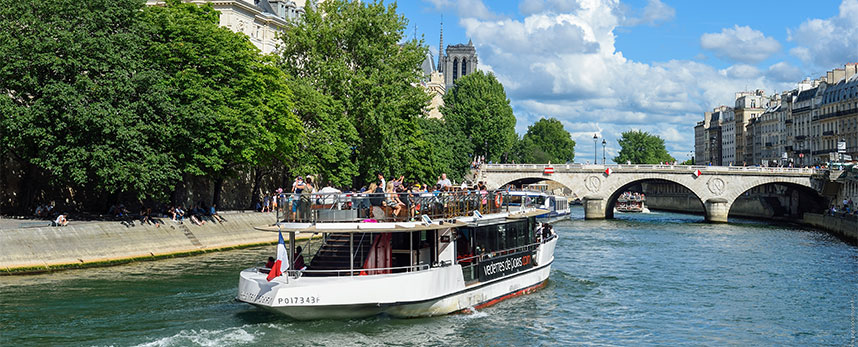The bateaux-mouches are a unique experience on the Seine in Paris. For over a century, these boats have transported thousands of people to discover the capital: the Eiffel Tower, the Louvre, the Musée d’Orsay, the Hôtel de Ville, Notre Dame de Paris …. The history of the bateaux-mouches is full of anecdotes that make this activity a memorable experience for tourists and Parisians alike.
The origins of riverboats
Contrary to popular belief, it all began in 19th-century Lyon, and more precisely in a working-class district of the city’s northern suburbs: La Mouche. This district on the banks of the Saône was home to a shipyard where boats were built. They left the yard in 1862 and very quickly took on the famous name of ‘bateaux-mouches’, under the aegis of Mr Plasson and Mr Chaize. The two men very quickly created the cruise company ‘Compagnie des Mouches’ to transport passengers.
Riverboats arrive in Paris
A few years later, in 1867, Mr Plasson took the initiative of responding to a call for tenders for the Paris Universal Exhibition and river transport for the Paris event. The company sent around thirty boats to the capital, and this means of transport was quickly adopted by Parisians. The bateaux-mouches made their appearance a decade before the Eiffel Tower!
They were so popular that they were still in use at the end of the exhibition. In fact, they made it possible to travel from bridge to bridge much more quickly than other means of transport at the time. Parisians loved them for crossing the Seine for around thirty years. The first written mention of bateaux mouche can be found in 1887 in a book by Paul Bert: “The bateaux-mouches that carry passengers on the Seine, crossing Paris and the suburbs, are steam-powered propeller-driven boats. They hold 300 to 400 people in their cabins and on deck. Thanks to their speed and low fares, they provide a great service to the people of Paris.
The advent of riverboats
It was the arrival of the Paris metro in July 1900 that rendered the use of bateaux mouches obsolete and consigned them to oblivion. It wasn’t until 1950 that the bateaux-mouches took on the tourist activity they enjoy today. After the Second World War, Jean Bruel restored and replicated examples of the bateaux-mouches from the Universal Exhibition and created the famous Bateaux Mouches company. He also created the character of Jean-Sébastien Mouche, who was to become the source of the urban legend surrounding the creation of bateaux-mouches. Together with a journalist from the famous newspaper Le Monde, they published a biography of Jean-Sébastien Mouche, the creator of a secret police force known as ‘les mouchards’. In 1953, at the inauguration of the company, the Minister of Transport and the Prefect of Paris took part in the masquerade by making a speech praising Mr Mouche.
Today, bateaux-mouches are as popular as ever, and offer a range of packages to suit the tourist trade. Boat companies offer day and night guided cruises in several languages for international visitors. The boats are also equipped with bars, restaurants and facilities for evening events. The famous romantic dinner cruise is a firm favourite with Parisians and other tourists.
The meaning of riverboats
The term ‘bateau-mouche’ therefore refers more to an activity than to a type of boat. For example, the Vedettes de Paris boats are not, strictly speaking, bateaux-mouches, but our offers are linked to a bateau-mouche activity: cruises guided by a tourist guide in French, audioguide available in French, English, German, Spanish, Italian, Dutch and Portuguese, aperitif cruise accompanied by music, catering on board and on the quayside, private hire of quayside areas and boats ….
The bateaux-mouches are an integral part of the history and culture of Paris. They have evolved over the years to become a popular way to discover the city and its panoramic views. The bateaux-mouches continue to attract millions of visitors every year and remain one of the city’s best-known symbols
 EN
EN FR
FR ES
ES
